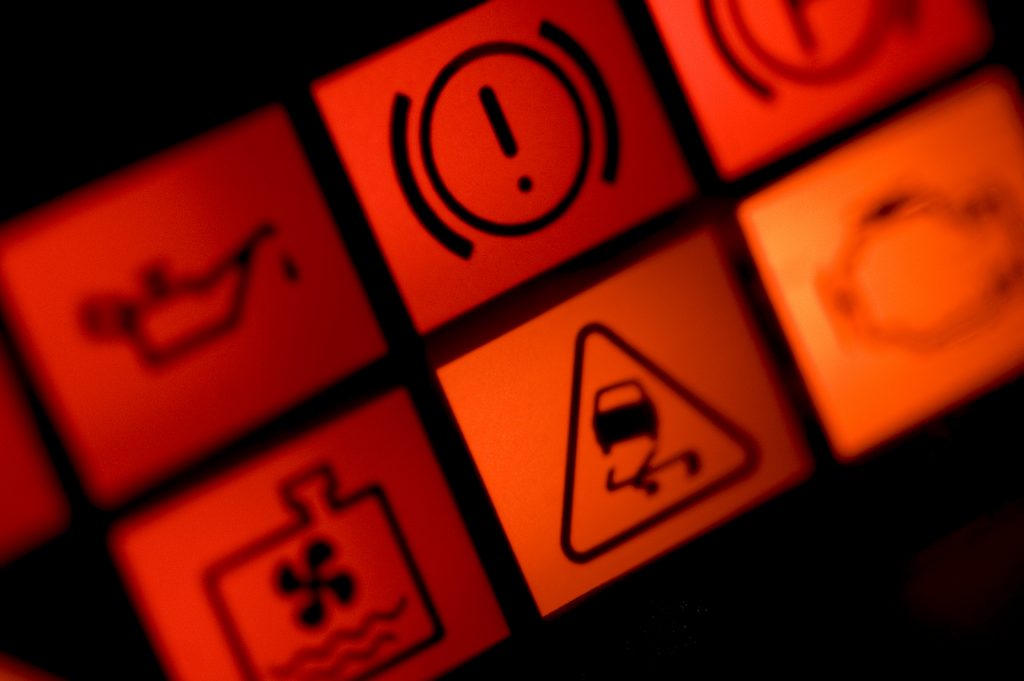A Warning Light is Flashing – Now What?
Posted October 1, 2021

Most drivers in Michigan can probably relate to the following scenario: hop into the car, start it, and instantly notice a warning light flashing angrily at you. That wasn’t on the last time you drove the car… or was it?
Don’t panic. Think. What does this flashing light represent? Consult your manual if you’re unsure, then follow these tips for things you can do to further assess the situation:
Battery Light
This light may come on when the voltage level is lower than it should be. It will also come on when your battery needs to be replaced. Some other issue with the car’s charging system could cause the battery light to come on as well. How can you get more information from your car?
What you can do: Open the hood and look at the battery. Is it obviously leaking or damaged? Check that the terminals and the connections are clean. If they are covered in residue, they may just need to be cleaned to allow for a proper charge. Do you have a battery tester? If so, use it to check the voltage output. This will clearly tell you if the battery itself isn’t working as it should be. If the light stays on, even after you’ve cleaned the battery, it’s probably best to pop into an auto-repair shop to have the issue professionally diagnosed and corrected if necessary.
ABS Light
If the ABS light is flashing, there may be a problem with your car’s anti-lock brake system. The ABS is comprised of a a system of sensors and hydraulic valves that work together to prevent one or more wheels from locking when you brake abruptly. It provides extra traction, allowing the driver to maintain the ability to steer while braking.
What you can do: In this case, there is not much you can ascertain on your own. We recommend that you schedule an appointment with a professional auto repair shop. It’s likely that the entire anti-lock brake system will disable itself until whatever issue is causing a problem can be corrected. You will be able to brake normally, but are more likely to skid or lose control of the car. Let an ASE-Certified technician take a look and diagnose the problem as soon as you can.
Check Engine Light
The vague Check Engine light can be especially alarming to drivers. This is also called the MIL, or the Malfunction Indicator Light. It means that something is malfunctioning within your car that has caused issued a Diagnostic Trouble Code, or DTC. The Check Engine light could indicate one or more problems, ranging from minor to severe. Identifying which Diagnostic Trouble Code can be done with a professional scanning tool.
What you can do: An easy thing to quickly check off the list of possible problems is the gas cap. Is it properly attached? If it is missing or even very loosely attached, the Check Engine light may turn on. If you check the gas cap and all is well, you should schedule an appointment to have the problem diagnosed. Possible issues include problems with the catalytic converter, spark plugs, wires, or air sensors. An auto technician can quickly ascertain which issue is the one causing your Check Engine light to come on.
Service Engine Soon
Similar to the Check Engine light, the Service Engine Soon alert can go off for any number of reasons. It can be set to come on simply as a reminder to change your oil, which is the most common reason.
What you can do: Look in your car for the sticker that indicates when you last had your oil changed. If you don’t have one, can you recall when it was? If it’s been too long, schedule one right away. You can also consult your car manual to make sure your car isn’t due for some other regular maintenance.
When any warning light comes on in your car, it’s important to keep in mind that their meanings can vary between makes and models. If you are ever unsure or have any questions regarding your vehicle, please don’t hesitate to call us at (616) 796-9929!
Categories: Car Repair
Tags:
Previous Post « Steering Wheel Shakes
Next Post Washing your Car During the Winter »
